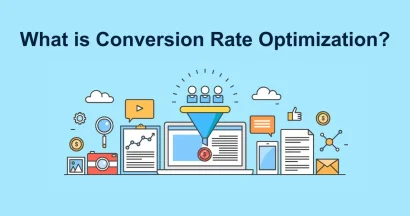Have you ever wondered which eCommerce business model is best suited for your online venture? With global eCommerce sales projected to reach $7.4 trillion by 2025, choosing the right business model can significantly impact your success. Whether you’re selling directly to consumers, catering to other businesses, or working with government agencies, each model has unique advantages and challenges.
This guide explores eCommerce business models, covering the most common types: B2B, B2C, B2G, C2C, C2B, B2B2C, D2C, and Hybrid. We’ll explain how each model works, its advantages, and its challenges to help you choose the best fit for your business goals.
Eduma – Education WordPress Theme
We provide an amazing WordPress theme with fast and responsive designs. Let’s find out!
What Is an eCommerce Business Model?
An eCommerce business model is the structure and strategy a company uses to sell goods or services online. It defines how a business operates, who its target customers are, and how it generates revenue through digital transactions. Understanding the best platforms to sell digital products online is crucial for businesses looking to maximize sales and reach a wider audience.
eCommerce business models can vary based on factors like the type of buyers and sellers involved (businesses, consumers, or government entities), the sales process, and the platform used. Some businesses sell directly to consumers (B2C), while others cater to other businesses (B2B) or even government agencies (B2G). Additionally, some companies eliminate middlemen with a direct-to-consumer (D2C) approach, while others operate through a hybrid model combining multiple strategies.
Choosing the right eCommerce business model is essential for success, as it impacts marketing, pricing, logistics, customer relationships, and aligns with the ideal marketing model for your business.
8+ Common eCommerce Business Model Types
1. Business-to-Business (B2B) eCommerce Business Model
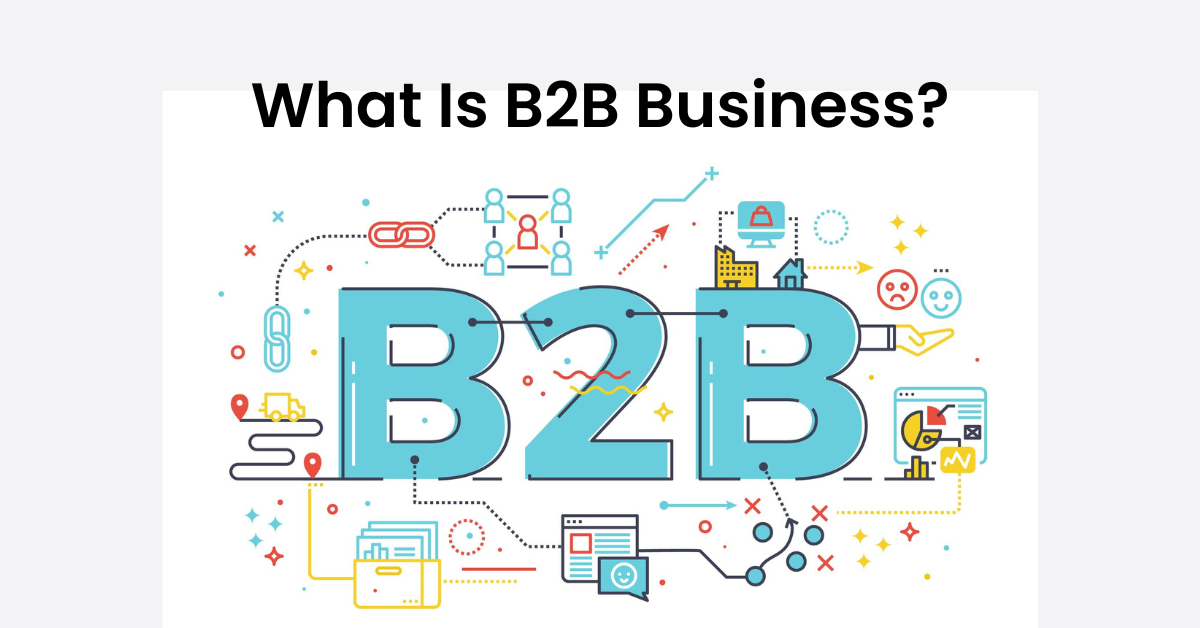
The Business-to-Business (B2B) revolves around transactions between two businesses, facilitating the trade of products or services. This encompasses manufacturers supplying wholesalers, wholesalers selling to retailers, and software providers offering enterprise solutions. This model is characterized by large-scale transactions, long-term partnerships, and specialized product offerings.
Prominent examples include Alibaba, Salesforce, and industrial suppliers like Uline.
B2B eCommerce platforms are designed to streamline procurement processes, automate order management, and foster enduring business relationships. The sales cycle in B2B is typically longer than in B2C due to extensive negotiations, complex contracts, and multi-tiered approval processes.
Pros:
- Higher Order Value: Businesses purchase in bulk, leading to substantial transaction values, enhancing revenue potential.
- Stronger Customer Relationships: B2B transactions often foster long-term partnerships, resulting in increased customer loyalty and predictable revenue.
- Scalability & Predictability: Recurring orders and contract-based sales contribute to stable and predictable revenue streams, enabling better forecasting and planning.
- Targeted Marketing: Focusing on specific industries allows for more efficient and cost-effective marketing strategies, reducing overall marketing expenses.
- Specialized Product Offerings: B2B companies can focus on niche products and services, creating deep expertise and value for their clients.
Cons:
- Longer Sales Cycle: Complex decision-making processes involving multiple stakeholders can prolong the sales cycle.
- Higher Customer Acquisition Cost (CAC): Reaching and converting business clients often requires personalized sales efforts and significant investment.
- Niche Market Size: B2B companies cater to specific industries, limiting the potential market compared to B2C.
- Complex Integrations: B2B platforms often require integrations with existing ERP and CRM systems, adding complexity.
2. Business-to-Consumer (B2C) eCommerce Business Model
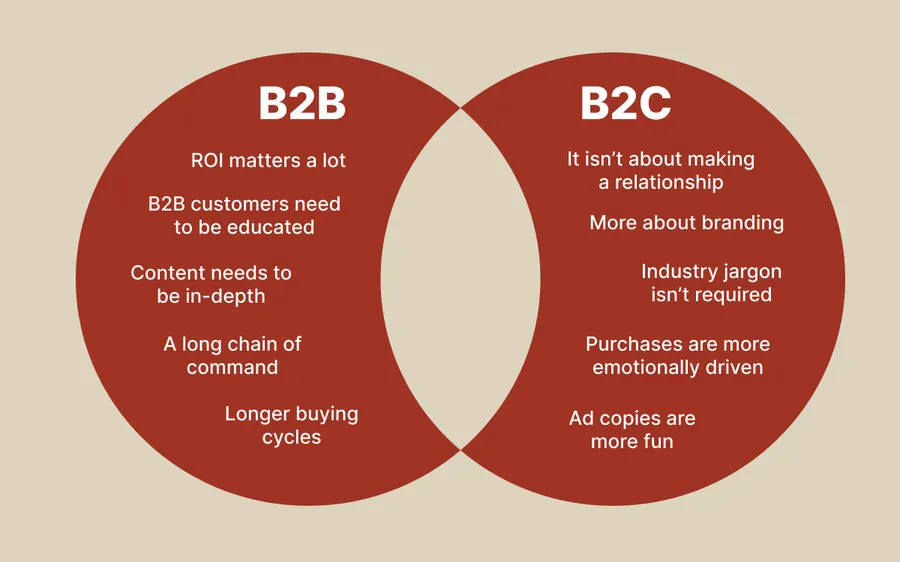
The Business-to-Consumer (B2C) is the most prevalent form of online retail, where businesses sell directly to individual consumers. This model emphasizes user-friendly shopping experiences, rapid transactions, and effective direct marketing.
Examples include Amazon, Walmart, and branded online stores like Nike.
B2C eCommerce thrives on impulse purchases, personalized recommendations, and seamless online shopping journeys. Mobile commerce and social media play significant roles in driving B2C sales.
Pros:
- Large Market Potential: Access to a vast global consumer base offers significant growth opportunities.
- Faster Sales Cycle: Consumers make quicker purchasing decisions, resulting in rapid conversion rates.
- Brand Loyalty & Engagement: Direct relationships with customers enable personalized marketing, fostering brand loyalty and engagement.
- Multiple Sales Channels: B2C businesses can leverage websites, mobile apps, social media, and marketplaces to reach customers.
- Data Driven Marketing: B2C companies can easily collect and analyze user data to optimize marketing campaigns.
Cons:
- Intense Competition: The B2C market is highly competitive, requiring continuous innovation and differentiation.
- Lower Average Order Value: Individual consumer purchases typically have lower values compared to B2B transactions.
- Customer Retention Challenges: Consumers are price-sensitive and easily switch brands, making retention difficult.
- High Marketing Costs: Reaching and engaging a large consumer base requires significant advertising investment.
- Complex Logistics: Handling large volumes of small individual orders can create logistical challenges.
3. Business-to-Government (B2G) eCommerce Business Model
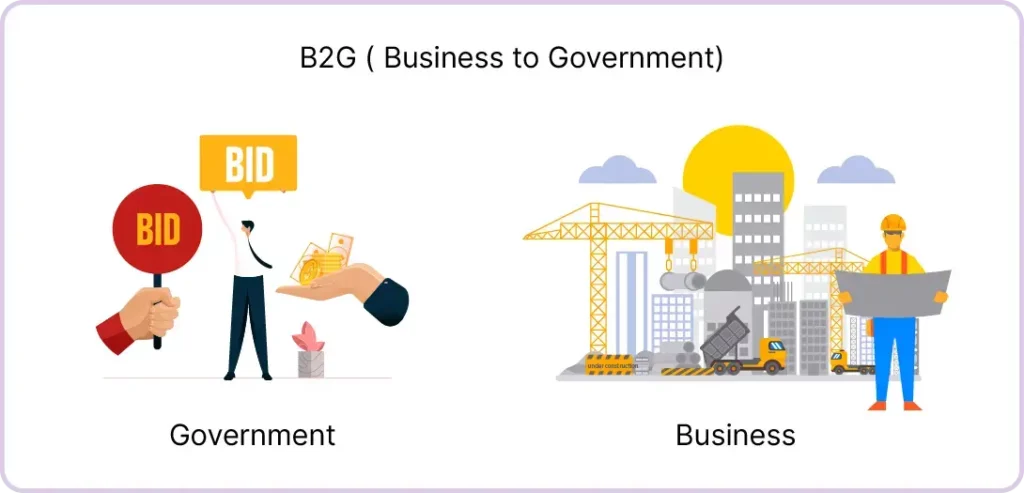
The Business-to-Government (B2G) involves businesses providing products or services to government entities, agencies, and municipalities. This model is characterized by formal bidding processes, strict compliance requirements, and large-scale contracts.
Examples include IBM providing IT solutions to government agencies and defense contractors.
B2G eCommerce often involves specialized platforms for procurement, contract management, and compliance reporting.
Pros:
- High Revenue Potential: Government contracts are typically large and long-term, ensuring stable revenue.
- Reliable Payments: Governments are reliable payers, minimizing financial risks.
- Reduced Competition: Fewer companies qualify to work with government agencies, reducing competitive pressures.
- Long term contracts: B2G contracts often span years, which provides stability.
Cons:
- Complex Bidding Process: Securing government contracts requires extensive paperwork, compliance, and competitive bidding.
- Strict Regulations: Businesses must adhere to stringent government standards, audits, and policies.
- Slow Payment Cycles: Government payment processes can be lengthy and bureaucratic.
- Transparency and Compliance: Government contracts require high levels of transparency and compliance, which can be difficult.
4. Consumer-to-Consumer (C2C) eCommerce Business Model
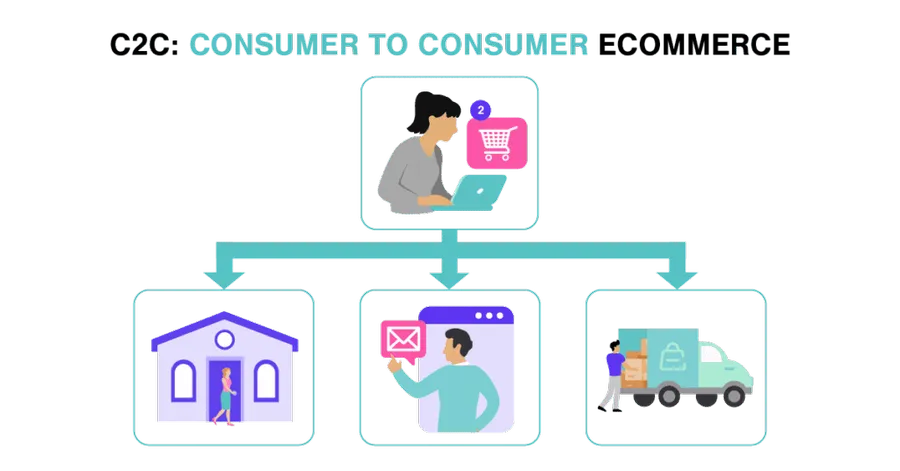
The Consumer-to-Consumer (C2C) facilitates peer-to-peer transactions, enabling individuals to buy and sell products or services directly.
Online marketplaces, auction sites, and social commerce platforms like eBay, Craigslist, Facebook Marketplace, and Depop are central to this model.
C2C eCommerce democratizes commerce, allowing individuals to monetize their assets and connect with buyers globally.
Pros:
- Low Entry Barrier: Anyone can start selling without significant investment or business registration.
- Wide Market Reach: Platforms provide access to a large audience without building a dedicated website.
- Sustainability: C2C promotes the reuse of goods, contributing to a more sustainable economy.
- Niche Markets: C2C platforms allow for the sale of niche or unique items.
Cons:
- Lack of Quality Control: Buyers face risks like fraud, counterfeit products, and misrepresentation.
- Inconsistent Income: Sellers do not have stable revenue streams.
- Platform Fees: Marketplaces charge commissions or listing fees, impacting profitability.
- Customer Service: The seller is responsible for all customer service.
5. Consumer-to-Business (C2B) eCommerce Business Model
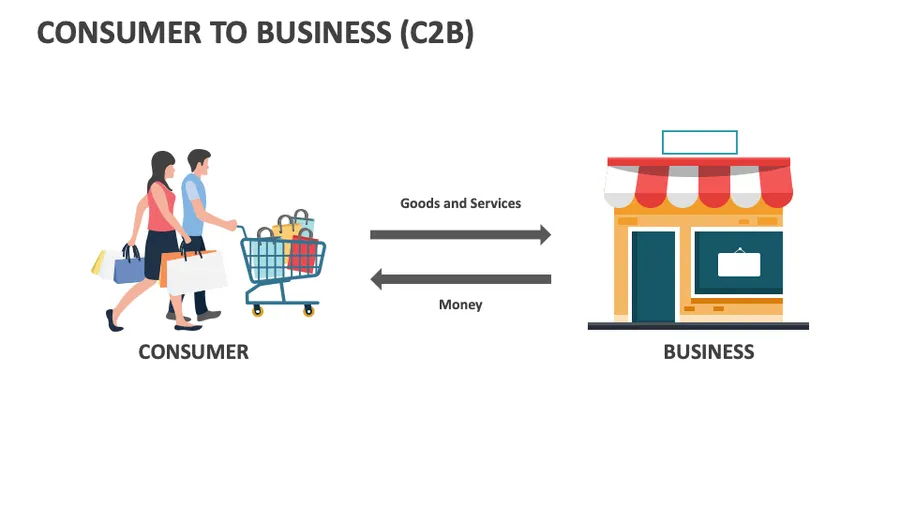
The Consumer-to-Business (C2B) flips the traditional dynamic by empowering individuals to offer their products or services to businesses. This model leverages the power of individual talent, influence, and creativity.
Freelancers on platforms like Fiverr and Upwork, influencers promoting brands on social media, and content creators selling digital assets to companies are prime examples of a thriving freelance business in the digital economy.
C2B thrives on digital platforms that facilitate connections between businesses and individual providers, fostering a dynamic marketplace of specialized skills and unique offerings.
Pros:
- Flexible Work Arrangements: Individuals enjoy autonomy and control over their work schedules and projects.
- Low Overhead Costs: C2B businesses often require minimal investment, reducing financial risks.
- Global Opportunities: Online platforms enable individuals to access a global client base, transcending geographical limitations.
- Specialized skills: Businesses can access very niche skills that they may not have in house.
Cons:
- Inconsistent Income: Project-based revenue can fluctuate, leading to income instability.
- Intense Competition: The C2B market is highly competitive, requiring individuals to differentiate themselves.
- Platform Dependency: Reliance on third-party platforms can expose individuals to policy changes and fee structures.
- Payment delays: Payments can be delayed depending on the client.
6. Business-to-Business-to-Consumer (B2B2C) eCommerce Business Model
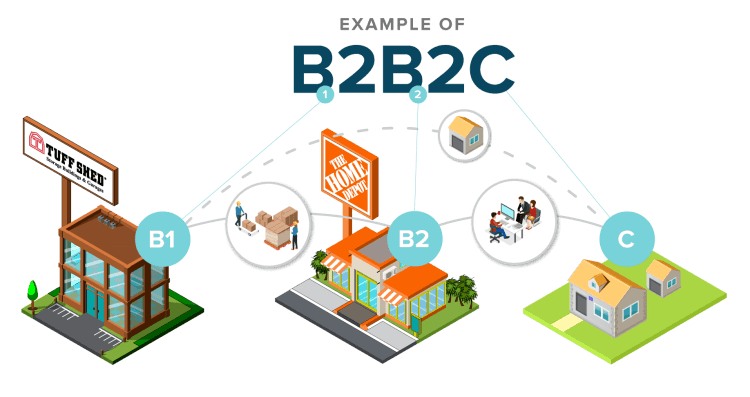
The Business-to-Business-to-Consumer (B2B2C) blends B2B and B2C elements, creating a symbiotic relationship between businesses and consumers. A company supplies products or services to another business, which then sells them to end consumers.
Examples include a manufacturer providing components to a retailer, who then markets the final product to consumers.
B2B2C leverages the strengths of both B2B and B2C, enabling businesses to expand their market reach and diversify revenue streams.
Pros:
- Scalability: Businesses can expand their reach by partnering with established retailers or distributors.
- Reduced Marketing Efforts: Partner businesses handle consumer engagement and sales, minimizing marketing costs.
- Diversified Revenue Streams: Companies can generate revenue from both bulk sales and indirect consumer sales.
- Increased product exposure: partnering with popular retailers can greatly increase product visibility.
Cons:
- Lower Profit Margins: Intermediaries take a share of the revenue, reducing profit margins.
- Limited Brand Control: The end-consumer experience is influenced by the partner business, potentially diluting brand consistency.
- Complex Supply Chain Management: Coordinating inventory, logistics, and partnerships requires meticulous planning.
- Dependence on partners: The success of the business is dependant on the success of their partners.
7. Direct-to-Consumer (D2C) eCommerce Business Model
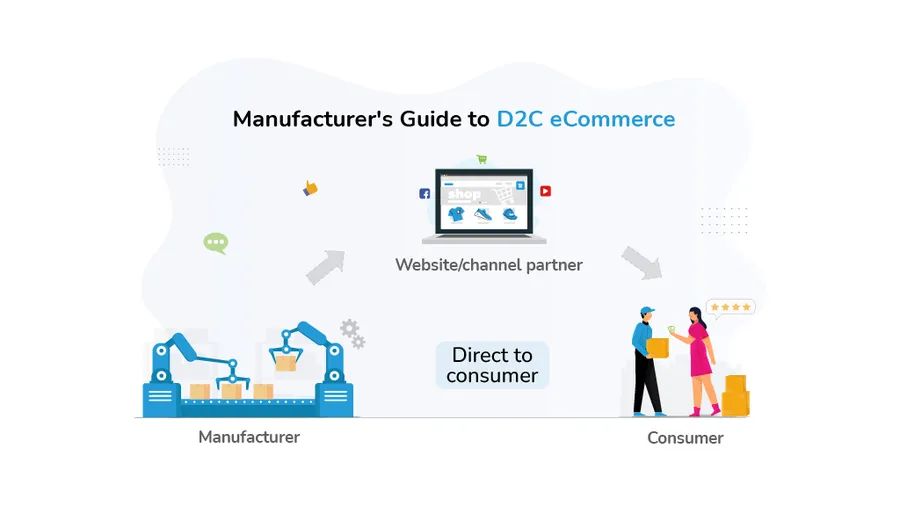
The Direct-to-Consumer (D2C) eliminates intermediaries, allowing brands to sell directly to consumers through their own websites, apps, or social media platforms.
Warby Parker, Dollar Shave Club, and Tesla are prominent examples of D2C brands.
D2C empowers brands to control their customer experience, build direct relationships, and leverage data-driven marketing strategies.
Pros:
- Higher Profit Margins: Eliminating intermediaries increases profit margins.
- Complete Brand Control: Businesses maintain control over branding, pricing, and customer service.
- Customer Data Ownership: Companies collect valuable consumer data for targeted marketing and product development.
- Direct Customer Feedback: Direct relationships allow for fast and accurate customer feedback.
Cons:
- Significant Marketing Costs: Building brand awareness and driving traffic requires substantial marketing investments.
- Logistics and Fulfillment Challenges: Managing inventory, shipping, and customer service can be complex.
- Customer Acquisition Costs: Attracting and retaining customers without retailer support can be challenging.
- Scaling difficulties: Scaling a d2c business can be difficult without the infrastructure that established retailers provide.
8. Hybrid eCommerce Business Model
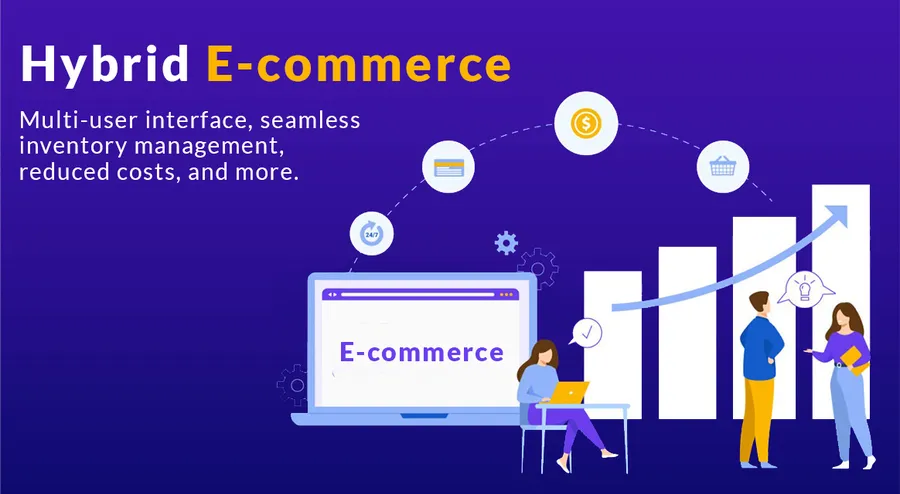
The Hybrid eCommerce business model combines multiple eCommerce approaches to maximize market penetration and revenue potential. A business might operate B2B and B2C simultaneously, sell through marketplaces and its own website, or integrate retail and D2C strategies.
Amazon, which operates both B2C and B2B marketplaces, and Apple, which sells through its website and third-party retailers, exemplify the hybrid model.
Hybrid models provide flexibility and adaptability, enabling businesses to capitalize on diverse market opportunities.
Pros:
- Diversified Revenue Streams: Businesses can tap into multiple market segments, enhancing revenue stability.
- Expanded Market Reach: Selling through various channels increases brand visibility and customer acquisition.
- Flexibility and Adaptability: Companies can adjust strategies based on market trends and customer preferences.
- Reduced risk: By diversifying sales channels, businesses are less vulnerable to fluctuations in a single market.
Cons:
- Complex Operational Management: Managing multiple sales models requires robust logistics and operational capabilities.
- Increased Operational Costs: Running multiple channels increases operational expenses and resource allocation.
- Brand Consistency Challenges: Maintaining a consistent brand experience across diverse platforms can be difficult.
- Inventory Management: Managing inventory across multiple channels can be difficult.
Quick Comparison Table
| Model | Ideal For | Key Risk |
|---|---|---|
| B2B | Bulk/enterprise clients | Long sales cycle |
| B2C | Consumer market, brand build | High competition & CAC |
| B2G | Public-sector contracts | Complex procurement & compliance |
| C2C | Peer marketplaces | Quality control & trust issues |
| C2B | Individual talent to businesses | Income instability & platform dependence |
| B2B2C | Manufacturer & retailer chain | Channel margin & brand control |
| D2C | Brand-direct consumer relationship | Must manage entire funnel & fulfilment |
| Marketplace | Platform operator | Building supply & demand, governance |
| Hybrid | Scaling/multi-channel brands | Operational complexity |
Emerging Trends Impacting Model Choice
- Mobile-first commerce: Mobile devices now dominate eCommerce usage in many markets.
- Social commerce & marketplaces: Social platforms are increasingly becoming commerce hubs.
- AI & personalization: Using AI for product recommendations, pricing, customer service is becoming standard.
- Global / cross-border expansion: Growth in emerging markets means you may choose a model amenable to international scale.
- Sustainability and circular commerce: Models like C2C, marketplaces, value reuse and second-hand goods.
- Hybrid flexibility: Because buyer behaviour and tech evolve fast, models that allow pivoting (hybrid) provide resilience.
How to Choose the Right Model for Your Business
- Identify your target buyer: Business, consumer, government, peer?
- Assess your product/service: Is it high-volume/low-margin (B2C)? High-value/low-volume (B2B)? Recurring (subscription) or one-time?
- Evaluate your operational capability: Can you manage fulfilment direct to thousands of consumers? Or is your strength servicing other businesses?
- Consider marketing and customer acquisition cost (CAC): Consumer audiences often require heavy ad spend; B2B may require sales teams.
- Think about scaling and flexibility: Do you plan to expand channels, go global, or add partners? Then hybrid or marketplace may suit.
- Review trends in your region: For example, in Southeast Asia (including Vietnam) mobile commerce and social commerce are strong; pick a model aligned with market behaviour.
- Set KPIs early: For each model, define key metrics (order value, repeat rate, margin, customer lifetime value). Then monitor and optimise.
FAQs About eCommerce Business Models
What is the best eCommerce business model?
There’s no one-size-fits-all model — it depends on your product type, target market, and resources. However, D2C (Direct-to-Consumer) and Hybrid models are trending in 2025 thanks to higher profit margins, better customer relationships, and flexibility across multiple channels.
What are the four main types of eCommerce business models?
The four primary types are:
B2B (Business-to-Business)
B2C (Business-to-Consumer)
C2C (Consumer-to-Consumer)
C2B (Consumer-to-Business)
Other variants like D2C, B2G, and Hybrid have become common as digital commerce evolves.
How do I choose the right eCommerce business model for my startup?
Identify your target audience, product category, and operational capacity.
If you sell digital products or want full brand control, D2C is ideal.
If you plan to resell or supply other businesses, go B2B.
For flexible scaling, consider a Hybrid or Marketplace approach.
What is the difference between B2B and B2C eCommerce?
B2B focuses on selling products or services to other businesses — transactions are high-value, long-term, and often contractual.
B2C targets individual consumers with faster, smaller-value purchases driven by marketing and brand loyalty.
Is D2C the future of eCommerce?
Yes — D2C is growing rapidly in 2025, driven by social commerce, influencer marketing, and first-party customer data ownership. Brands like Glossier and Gymshark have proven the model’s scalability and profitability.
Final Thoughts
Choosing the right eCommerce business model is a foundational decision — it affects your entire business strategy from marketing to fulfilment to growth. Each model has inherent strengths and challenges; the “best” model depends on your product, audience, resources, and aspirations.
As the online commerce landscape advances (with mobile, social, AI and global expansion accelerating), the businesses that win are those that align a strong model with operational excellence and market-smart execution.
Take the time to map your model now, then build your infrastructure, marketing and logistics around it. That way you won’t just enter the eCommerce race — you’ll position yourself to win.
Read more:
How To Grow Your Freelance Business?
What is Content Marketing? Best Guide for Beginners
Instantly Boost Your Rankings: 8 Powerful AI Search Engine Optimization Tools
Contact US | ThimPress:
Website: https://thimpress.com/
Fanpage: https://www.facebook.com/ThimPress
YouTube: https://www.youtube.com/c/ThimPressDesign
Twitter (X): https://twitter.com/thimpress

